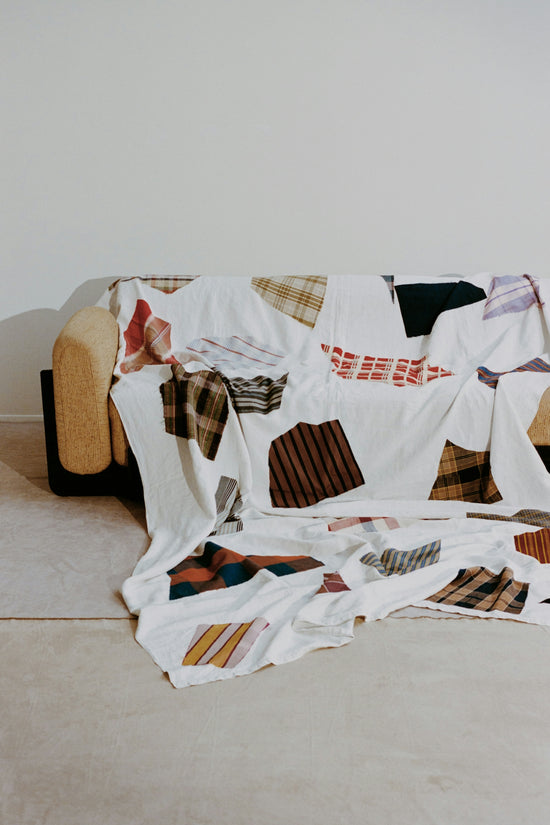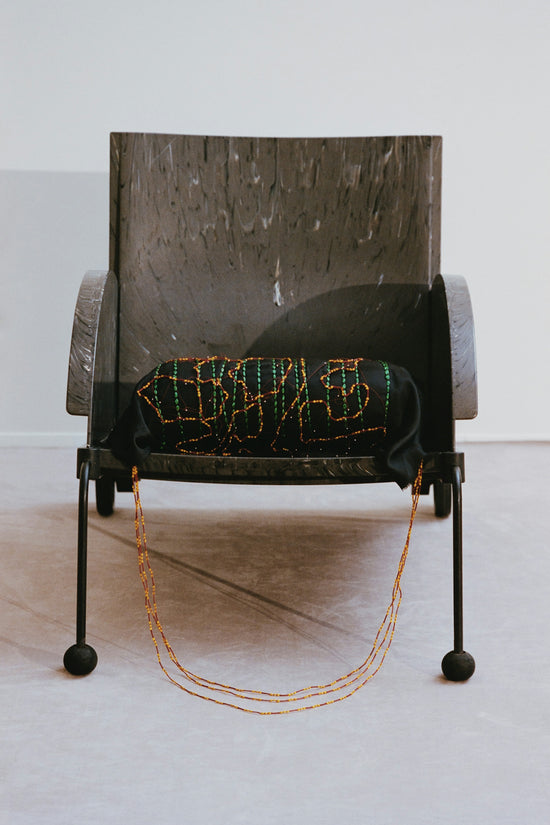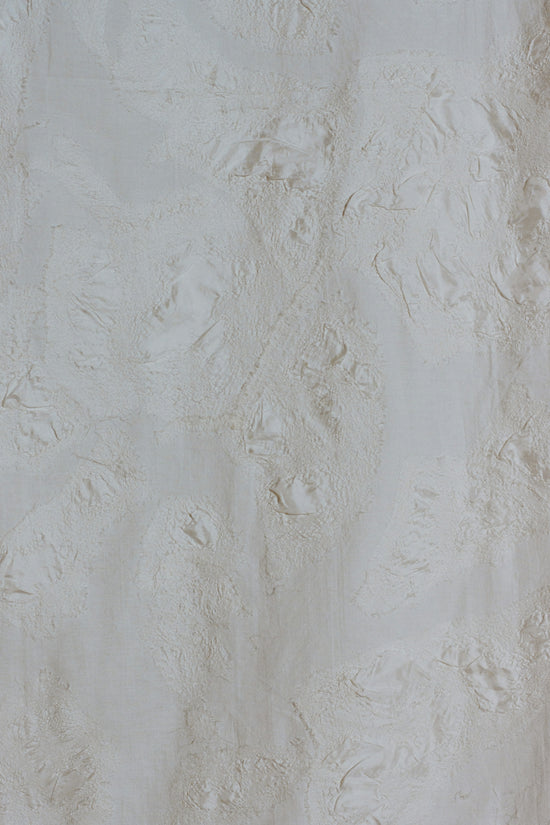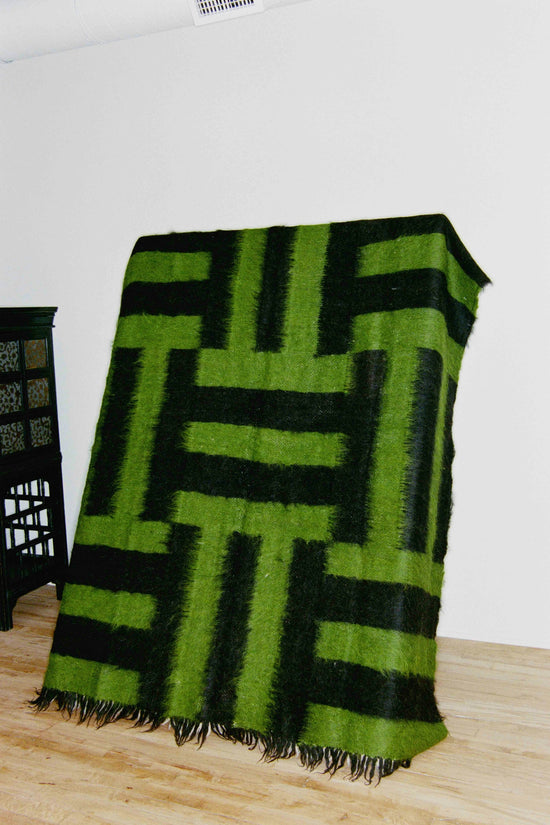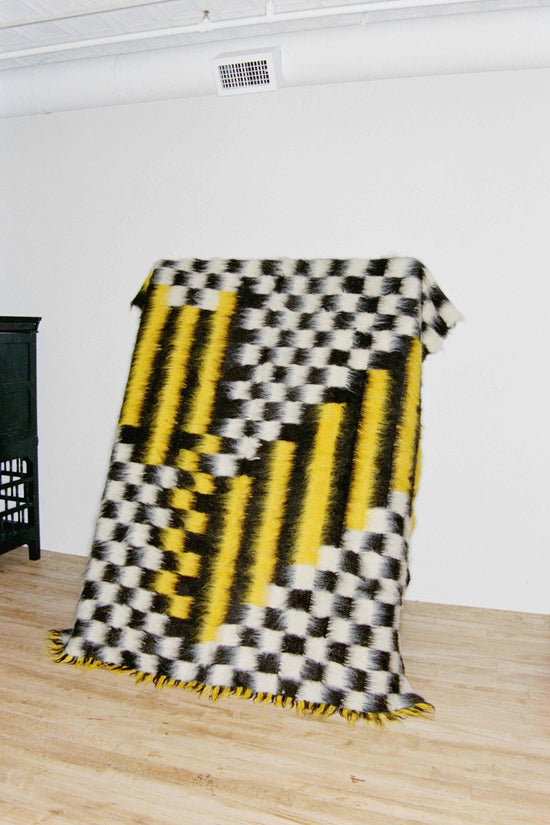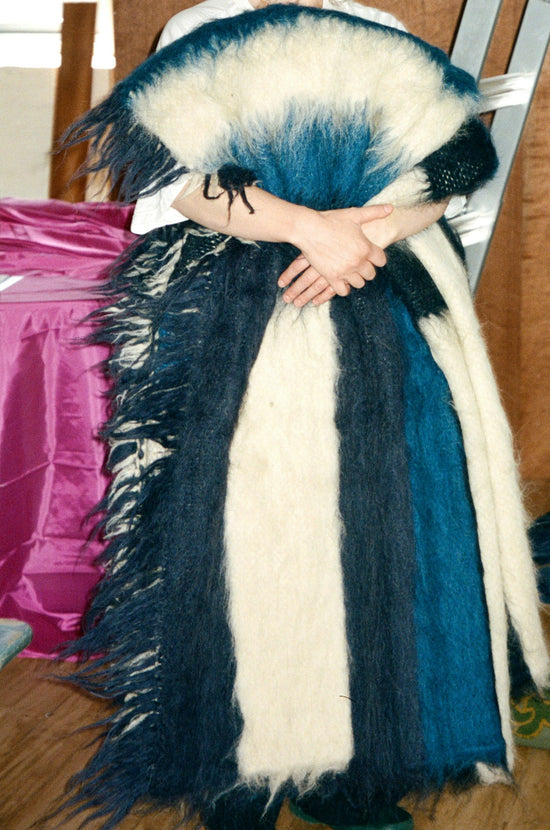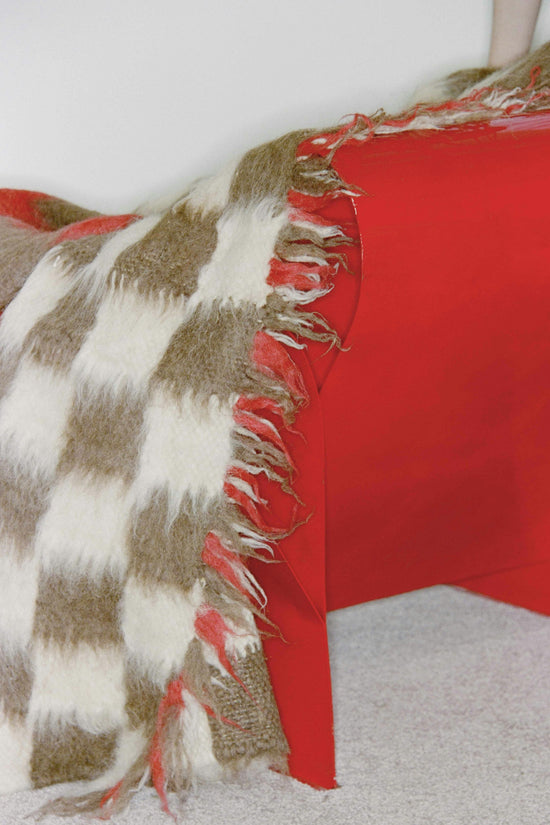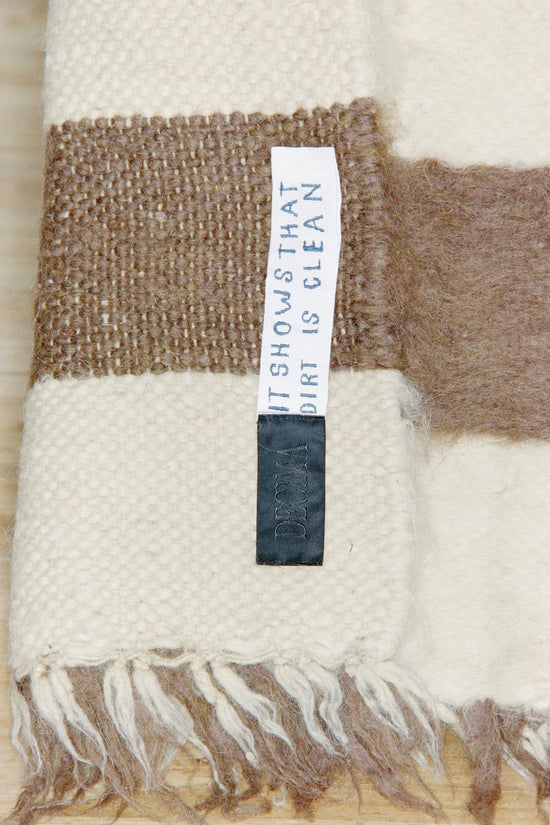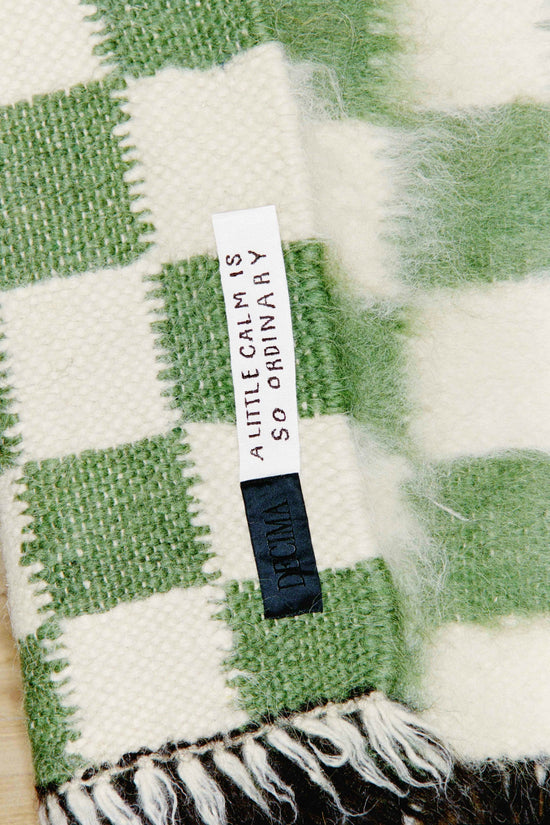Interview
Grace Atkinson
EB: Where you are and how are you doing?
GA: I am currently in Paris, working from my home studio, where I moved about ten months ago. Having a studio at home has been an incredible decision for me as it aligns perfectly with my natural workflow. It allows me to seamlessly transition in and out of projects in a more flexible way, which feels much smoother to me. During intense periods of focus, I can dive straight into work as soon as I wake up or continue working late into the night. I’m doing great! Over the past few weeks, I’ve been heavily focused on designing new wool pieces with the Ukrainian artisans I work with. This week, I felt the need to dive back into more tactile creation, so I’ve been reconnecting with my collection of fabrics and experimenting with different combinations. Today I’m spilling out into the living room so it's looking a bit chaotic here but I’m having a good time.
EB: I love that, the complete elimination of any kind of compartmentalization between the studio life and the life life. No boundaries.
GA: I think in the past when my trajectory wasn’t as defined it might have been difficult, but now as I have such a clear focus and my work is intrinsically integrated into my life, I love it as it alleviates a lot of pressure.
EB: How has your work evolved in the last two years? What’s so plain for me to see is this insistence on tenderness and care, but there's also many new materials and processes and forms and the presence of your own hand...
GA: A few of the pieces that are in this upcoming show I actually started making around 2019. I was briefly living in New York and I had my own studio space for the first time. I would walk there every morning, traversing the city for an hour and a half taking the time to reflect and take in the dynamic energy of New York, which felt so different to Paris. This time alone allowed me to create a space around myself where I could deeply focus on work and experiment with a lot of different things and refine some techniques that are integral to my work today.
When I returned to Paris, I continued to explore the more decorative aspects of my practice while also working on launching “Decima”, a studio through which I would produce interior pieces like rugs, blankets, and floor cushions made with artisanal techniques. At the time I was unsure how to reconcile these different modalities so there is a whole body of work that I have never shown until now. Today, I just make everything under my own name which has resolved any of those perceived constraints.
EB: Is there a specific example for the upcoming show that feels like a nice compliment to this new realization of embracing this kind of work, that for years you kept for yourself?
GA: These works being shown for A Room are quite intimate due to the emotionality of the materials used. Two of the pieces are my interpretation of Dakimakura cushions, which are usually these large cushions found in Japan that you are meant to sleep with or embrace. In the 90s Dakimakura became intertwined with Otaku culture, evolving into contemporary cushions featuring anime characters. I developed a strong attachment to the characters that I depict in these pieces, so even if it’s an idea that only exists in my imagination, my experience of transmuting their images into objects was cathartic for me, becoming sort of a psychic representation. I was also interested in exploring the idea of comfort and the senses through which we derive it. They have a soft form, but also have these extremely delicate elements which prevents you from using them in the typical way–for physical comfort through touch. These delicate elements function as a kind of shield or protection.
EB: I’m enjoying imagining the cushions as having this tension with its form that contrasts an expected functionality with the extreme delicacy of an artwork. What are the possibilities of having a relationship of softness to an object that's purely emotional or cerebral and not necessarily tactile or functional all the time?
GA: Completely. I think the tension is what’s interesting.
EB: You’ve written a little about how some of your works respond to nostalgia. How are you orienting yourself to it as a way to move forward, while not forgetting the past?
GA: I’m a deeply nostalgic collector at heart, but since leaving New Zealand as a teenager and moving many times, I’ve learned to be quite ruthless with my belongings and embrace minimalism. I try to balance a sensitivity and connection to objects infused with memories and experiences with the ability to let them go, trusting that an echo or shadow of them will remain.The “palimpsest” work parallels this, which is an improvised composition made up of personal artifacts. These former markings or materials are re-contextualised through a process of simultaneous erasure and revival.
“Soft Delirium” is the first piece using a specific technique that I had started making when I was living in New York. Back in Paris I finished the piece using an old frame that had various former markings, I added small engravings of symbols that were significant to me and now it has returned to its place of origin. The etymology of nostalgia comes from the Greek “return home” and “pain”. There’s a poetic beauty to this, but I think it’s an emotion that should be in flux so it doesn't become an intolerable weight. Perhaps this approach to my work is a way for me to realize nostalgia in a more tangible way and then emancipate it (and myself), so it becomes more of a celebration of associated memories.
EB: As you mentioned earlier, some of these pieces have been in the works for some time, but here they are, finally making their way outside of your world. What is your hope for how one can engage with and kind of communicate with these pieces?
GA: For me, the process is the most important aspect as it’s the majority of my day to day experience. Beyond that I’ve learnt that once you put things out into the world you relinquish control over how it will be perceived, things take on a life of their own. I’d love it if somebody connected with the work and wanted to look at it every day. These days I try not to get caught up in expectations and stay open to whatever happens.
EB: That's a pretty good place to be.
Continue to read Substance in a Cushion summer 2022 interview
EB: In your own words, what do you do?
GA: This is probably the hardest question anyone can ask me. And it's always been a question that's given me a lot of grief. But the simple answer, I think, is that I'm a textile designer. It's probably a complex question for me to answer simply because I've done so many different things in the course of my career, which have led me to this point. I do a lot of things at the same time, and in a lot of different fields between design, art and fashion. I get bored easily and I like to be busy, I like to be learning. If I don't feel like I'm learning and growing, then I start to get a bit antsy and I feel like I need to try something else.
EB: I would love to learn about the story of Decima.
GA: I've always worked with textiles. And in the last three or four years, I've had a practice making quite experimental one-off pieces. I've been making them out of silks, chiffons, antique fabrics, vintage sourced fabrics, and old clothes that are falling apart. For me, it was always just for pleasure. It's a very meditative practice, a way for me to really lose myself in this tactile kind of repetition, which I love. But these pieces are super fragile. I started thinking about and observing how their fragility informs the environment in which they can—or cannot—exist. They have to be entirely decorative pieces, they can only be looked at. Maybe they can be gently touched, but otherwise they're going to fall apart. I was thinking about my sensory experience with these textiles, and then textiles in general, on your person and your home.
I was feeling more and more drawn to the practical and robust nature of objects like rugs, cushions and blankets, which was in total opposition to what I'd been working on and creating. But I was also becoming drawn to the relationship between practicality and beauty so Decima was created to personify both of those things.
EB: Are the pieces for the gallery the inaugural works for your project?
GA: I have some other pieces that I’ve designed. At this point, I've only done a soft launch this past summer. They were the first pieces that I made that felt ready to be put out into the world and these were the ones that Jac and Ruby saw, which started our collaboration. Due to the artisanal nature of Decima, I always thought that if I was going to be showing or selling them anywhere else, it should be special pieces made for the environment in which they're going to be shown in. It all came together so well, because that was exactly what Jac had in mind. So the pieces I made for the gallery were designed, especially for her, especially for this space and they're all unique.
I also really enjoyed working from the brief that Jac gave me, which was a Gertrude Stein poem. I love Gertrude Stein and her work feels like quilted fragments of words. I love working with books and reading. Words are really important to me. They inspire me so I felt really excited to kind of go back into this poem and just kind of let my mind go and see what it evoked for me. That was the departure point.
EB: Literature feels like a fundamental through line, not only in your textile work, but as a creative practitioner. How do you relate to literature
GA: Literature and poetry has always been a really important part of how I spend my days. I was kind of blown away when Jac first contacted me. We first connected through this Lisa Robertson piece, which she loves as well. We were completely on the same page. I felt like it was a perfect match. I had a very good feeling about it right from the beginning. Reading is just a part of my life. For me, when I work, it’s a way to connect a lot to emotion, to being open, and feeling open. And I think anything that makes me feel connected to the world in a larger way is always gonna help me in my creative process, even if it's as specific as designing a motif for a textile piece.
EB: One of my immediate cold reads for the work was thinking about concrete poetry and text as pattern, as architecture, as repetition.
GA: During COVID, I’ve gotten way more into poetry. A lot of my friends and I began thinking in that moment that poets would show us the way! I was reading a lot of Susan Howe who was so amazing. I love reading her work and her concrete poetry, which is just so beautiful. There's this connection between the visual, the feeling and the perception.
EB: As a designer, I'd love to hear how you relate or respond to interior space. Especially given your shift in focus with Decima and thinking about making a more robust object that's meant to be used, loved and worn.
GA: Textile work has been in my family for generations. Since I was a child, I was exposed to things like technical skills and learning about the qualities of different fibers and fabrics. As I grew older I found myself often rejecting this part of me. I think I struggled with textile’s connection to domesticity and to antiquated roles of being a woman. But somehow, I would always find myself back with textiles, and when I finally decided to embrace it as my medium, everything started to come together. I was experimenting and playing, but I wanted to do something more considered. I'm always trying to create a sense of freedom for myself where it doesn't have to be serious, it can be just a beautiful, playful object that makes someone happy. And it's practical! I love creating something that can be used, that makes someone feel a certain way, that improves their life, is ergonomic or serves a purpose. There's a lot of beauty in that. And it's more democratic.
EB: I appreciate your use of language by defining Decima as providing "spatial textures to live with". To me, this implies action, a sensitivity to material and to the body. Where did this come from and how does it speak to your current compass bearing of creative work?
GA: When I use that phrasing I want to evoke a sense of space, of scale. There is this description of textures–which is plural–which to me, implies a space of multiple things in it. I like to think about how domestic spaces can be composed with many textures. With Decima, I'm trying to explore the use of these textiles that can be permanent or transitory within a space. You can move them around, you can change them, you can constantly be arranging things in different ways.
Whether it's this heavy rug, which frames the floor and sits and stays there. And then you can also have this light, soft throw, which is moving around the space, because it's wrapped around your shoulders or something like that.
EB: Can you tell me a bit about your process?
GA: It's not very rigid, that's for sure. I would even say it's quite emotional. I think with creative work, it's important to think of it as a constant process where you never quite stop working. You can always take things in. At this exact moment, I'm sitting here in central South France, in the countryside and the grass is really dry, I can see the sun shining behind me coming through the trees. There's a bit of this white-green, dried moss with an orange leaf and then a bit of green grass. It's beautiful! This can make me think about some textures that I want to create or a different kind of color palette. Or maybe that I'd love to shoot with this kind of light. I'm always trying to stay curious and open, always looking around me. I always go to exhibitions because I like to see what other people are creating. I like to get a feel for what is happening around me. It's my research. When I'm designing I really just go with a feeling or I'll try and create a feeling. Sometimes I'll just take some mushrooms and put my headphones on. I'll play music and just try to create in this trance state and focus on this one thing and draw 100 different designs. I love getting lost in that kind of world where you're really just exploring things without judgment. I will then refine, edit and change and start to play around with different combinations.
Everything I'm doing is about experimentation. I'm still in the process of learning the natural qualities of these textiles, because of the weaving and brushing techniques. I’m seeing how far I can push the limitations that exist for different reasons. The actual technique of making them as well as the artisans that do it blow my mind. It is incredible and humbling to work with them.
I also love thinking about geometric motifs. You can have one motif and your perception of it is all about focus. If you focus on one small part of it, it looks one way and as soon as it's multiplied and expanded, it becomes something completely different. Color is very powerful at distorting those perceptions as well. You see that as well in these pieces that I designed for Jac. They are 10 unique pieces, but they're coming from two separate motifs that are all different color combinations or slight design variations. You see how differently they feel when it's bright, yellow and black as opposed to green, white and black. Or how one with blues and a white just looks like a complete different thing. I love that.
EB: I appreciate you describing your process as emotional. There's a lot of power in working from emotions and trusting your gut. It really feels like that kind of dynamic is fundamental to how your pieces are coming out into the world.
GA: It's definitely not my intrinsic nature to be that way with work. In my professional life I'm an absolute perfectionist. I love to feel like I'm in control of things. If the colors are not right I feel it in my body. A lot of these pieces are made in Ukraine and involve working with so many different people. I've been forced to really let go of my attachment to things being a certain way and just kind of embracing their beauty for however they end up. That's been really freeing for me.
EB: Jacqueline shared some behind the scene images of the work being photographed and seeing the pieces in context with bodies was really amazing.
GA: I love playing with scale. Some of the first prototypes I was working with were a more traditional size, a lot smaller. When I got them I knew that they needed to be giant. I wanted them to feel like they have their own voice. And they really lend themselves to being big.
EB: In creative practices, I like to think about translation as a metaphor. With Decima, you're sending finished, super dialed in designs to the artisans. Something will be lost and something gained. We don't even have to talk solely about the poetics of it, because it's also about geography, resources and deadlines.
GA: I love that you talk about translation. First of all, there's me translating my own idea into a visual representation that can be used to communicate that idea to someone else. But like you said, it's then the artisan translating it into what they perceive what they think I'm trying to communicate. But it's also the actual textiles and fibers, the technique and process that translates as well. I often feel as though I am in conversation with the textiles. There were all these things that I was discovering, as I was making more and more pieces where I was like, oh, this is what happens when I have the vertical line and a horizontal line together.
Especially with this brushing, you have these visual effects that are completely different that you wouldn't understand when you see a drawing or a rendering that I've done, which is 2d and it doesn't take into account textures. And then suddenly, you see this blanket and it's like no, this is what I am actually! How can I then push that and make it really purposeful?
EB: As far as your materials go, I can't help but think about how it pertains to softness and comfort. The relationship between textiles and the body, textiles as healers and protectors. These feel like things that are very much in your zone.
GA: As soon as you say that, I think back to how I was drawn to making something that was practical and beautiful. The warmth, coziness and comfort that these blankets or textiles can create when you use them is their utility. Which is funny because that's a really emotional utility to have. It's something that really evokes an emotion and a feeling, but also it's so interesting that you bring up healing. The wool pieces are made in Ukraine using sheep from the region. This rug or blanket is entirely hand crafted using a traditional technique developed in the 14th Century by the Hutsuls; highlanders who have inhabited the Carpathian mountains of Ukraine for centuries, intrinsically bound to the earth through ancient myth, mysticism and folklore. Believed to be samoridny (self-born), and revered for their healing and medicinal properties, these magical pieces are created in direct synergy with nature. There’s something truly healing when you touch or are covered in these natural fibers.
EB: Do you mind talking about the process for how the wool pieces in Ukraine are made?
GA: They are made with quality virgin wool from the regional mountain sheep, each piece is woven by hand on a wooden loom, then submerged in the mountain river to gently felt the wool fibres. After being laid out in the sun to naturally dry, they are hand brushed on one side to create the soft, fleecy texture.
I love this connection with nature and using the environment and resources around you. Sometimes when it's too cold during winter, the river freezes over. So there, they have to halt production, which can be a bit frustrating, but there's also something really magical about that, really working with nature.
EB: Have the artisans been safe during such a dangerous and precarious time in Ukraine?
GA: It’s a devastating situation. For the first few months communication was complicated, and when news would finally come it was describing situations of absolute despair. I am in awe of the strength and tenacity of the Ukrainian women that I work with. At one point they decided to resume work, to try and establish some sense of normality among the violence.
We have been working together now for over four years and are continually reassessing how to maintain a working relationship that is supportive, enriching and sustainable.
EB: They seem like some of the strongest people imaginable.
GA: It's incredible. It definitely looks that way to me.
EB: What feels important for you right now as a designer and as a human?
GA: I want to live and create in a way that contributes and doesn’t destroy. At this moment in my life, my focus is a constant shift towards connection, joy and growth.
